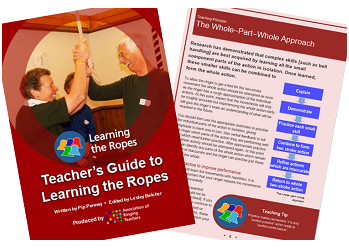Score from successful goals
In this article we will look at the various types of goals which can be used and when each type of goal might be useful to us when we are teaching ringers.
- What do you think of when you set goals for your ringers?
- Do you have a long term goal for your ringers or for your band?
- How do you plan the actions necessary to achieve your long term goals?
Long-term Goals
The long-term goal is the eventual target, in a way it is like an overall strategy. Long-term goals can be set for a band, for example becoming an 8-spliced ringing band or for an individual, for example ringing a first quarter or learning Plain Bob Doubles. It is important to have a long-term goal to aim towards, something to work towards. However, by definition long term goals take a long time to reach and this may make them seem remote and rather unachievable, a ringer may give up trying as there is no immediate success to create confidence and motivation.
Short-term Goals
Short-term goals can be used as stepping stones along the way to the long term goal providing recognisable achievements along the way. Short-term goals can be specific and may be designed to work towards a certain part of the overall long term goal. These short-term goals can be used to improve any aspect of performance; handling, bell control, theory and concentration for example.
When each goal is achieved there is a boost to the ringers confidence and therefore to his or her motivation. It feels good to achieve something you have set out to complete.
Achievement Goals
Often ringers think of goals in terms of ringing a quarter peal of a certain method, perhaps a pass of the higher Levels of Learning the Ropes. This type of goal is known as an Achievement Goal. The goal is directed at achieving a target.
The problem with this sort of goal is that all the factors involved in achieving it are not controllable by the individual ringer. That is to say the achievement of the individual ringer is reliant upon the performance of others. Other ringers may go wrong or the quarter may be miscalled for example. This lack of controllability may lead to disappointment and frustration. For this reason focusing only on Achievement Goals may have unpredicted negative effects.
It is important that ringers achieve success, as without success they are likely to lose confidence in their own abilities.
There are other types of goals which are more controllable and can be used along the way to enhance confidence and motivation along the way to the eventual achievement goal.
Performance Goals
Performance Goals focus on improving performance [ringing with rhythm, improving striking, attending more frequently] that is to say on achieving a set of standards. Performance goals encourage the development of mastery of the skill, that is improving the standard of the ringing and can make a ringer feel satisfied with a performance.
These targets can be worked on by the ringer independently and are not reliant on the performance of other ringers. These goals relate to factors within the control of the ringer. Examples include:
- Improve rhythm on six – by ringing lots of Plain Hunt from different bells
- Improve 3/4 up dodge in Plain Bob Doubles – by ringing Bayles Bob Doubles
- Improve ringing up and down in peal – by practising on 3 then 4 then 6 then 8 bells
- Improve striking in Doubles Methods – by learning and ringing four new Doubles methods
- Improve treble ringing to Cambridge Surprise Minor – by ringing Treble Bob Hunt as an exercise
Process Goals
Process Goals focus on controllable factors that will result in improvement, they can be used to concentrate on or to emphasise areas where a ringer needs to work to improve technique. For example: bell control, handling style, handling skills – such as pulling right through or catching the tail end after the handstroke pull, or listening skills, using a simulator or learning theory
- Improve dodging striking at backstroke – by practising taking in and letting out rope
- Improve accuracy of moving bell at handstroke and backstroke – kaleidoscope sequences
- Improve ability to set bell – bell control exercises such as "Twinkle, Twinkle, Little Star"
- Reduce method mistakes – learn theory more thoroughly, using quizzes, questioning, write out on board
Remember as a teacher to give feedback!
Research has demonstrated that by focusing on Performance Goals and Process Goals which are controllable rather than just on achievement goals, individuals are more likely to become more confident and better able to concentrate.
It is our responsibility as teachers to help set goals which can be realistically achieved.

Teacher's Guide to Learning the Ropes
A book for any ringing teacher, covering the “how to” from the first bell handling lesson to teaching someone how to ring their first method.
The Teacher's Guide and its companion publication The Ringer's Guide to Learning the Ropes are both available from the ART shop.
Pip Penney